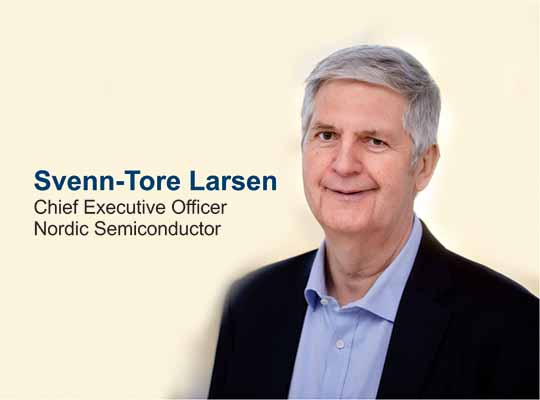While talking about many aspects of the pandemic, supply chain, coping up during the pandemic, market forecasts and further expectations, Svenn-Tore Larsen | Chief Executive Officer | Nordic Semiconductor gets alongside TimesTech Buzz. Larsen also talks about how sustainability is a Megatrend in Nordic and their vision while he pins the reality of chip shortage. Much more interesting reads in the below interview.
TimesTech Buzz: What are the challenges and possibilities Nordic encountered in 2021?
Svenn-Tore: The pandemic’s global impact on society and the world economy has in turn affected the organization and operations of Nordic Semiconductor. The company’s focus during a challenging year has been to foremost safeguard our staff, followed by ensuring business continuity for customers, suppliers and partners.
While Covid-19 has had a huge negative impact on the world overall, on the positive side it has been the catalyst behind a dramatic mainstream uptake in a range of technologies that were previously confined to niches. For example, the boom in online shopping and the need to transport billions of vaccines across the globe has accelerated technologies in the logistics, asset tracking and location services sectors. The pandemic has also triggered major interest in wearables and other connected devices that initially supported social distancing and contact tracing to slow down the progress of Covid-19 but can now be turned to other novel applications. Nordic’s technology has been used in dozens of innovative designs for these and many other boom sectors during 2021 resulting in the company’s revenue doubling over the last two years.
But Covid-19 has brought challenges to Nordic too. For example, semiconductor chip supply has been subject to major constraints which have extended lead times. The impact has been felt most in booming sectors such as healthcare, smart home, asset tracking, and Virtual Reality (VR)/Augmented Reality (AR), but there are supply challenges across all sectors. Nordic staff have worked tirelessly with the company’s suppliers to increase inventory and with customers to help them overcome component shortages. The situation is improving but it will be many months before normal lead times return.
TimesTech Buzz: What are the Nordic’s market forecasts and expectations in 2022?
Svenn-Tore: The IoT is expanding exponentially. Analyst, IoT Analytics, for example, reports that by the end of 2021 there were around 12.3 billion devices connected to the IoT. The company says that by 2025, that number will have reached 27 billion. Nordic is seeing this growth across a wide range of sectors including the Industrial IoT (IIoT), logistics, smart home, healthcare, retail, consumer and education among others.
More specifically the company sees three ‘megatrends’ driving the growth of the IoT: Industrial IoT, sustainable solutions and platform ecosystems.
Industrial IoT is transforming the industry by connecting everything. Connectivity boosts safety, productivity, quality and innovation in the manufacturing environment. Sensors and gateways feed data from the physical world to the digital world of Cloud computing and AI/Machine Learning (ML). There, the data can be analysed to produce actionable insights that will optimise manufacturing processes. Finally, those insights can command actuators to modify processes to make them more efficient. The sequence continues as a positive feedback loop.
Sustainability equally depends on wireless technology. Nordic is a member of the Responsible Business Alliance (RBA), the world’s largest industry coalition dedicated to corporate social responsibility (CSR) in global supply chains. As part of the RBA and other initiatives, the company is committed to developing technology that will help realise the UN’s 17 Sustainable Development Goals. Nordic is also committed to helping its customers use the IoT to solve sustainability challenges. The company’s technology is helping to clean up the air and water, limit carbon emissions, tackle deforestation and protect endangered species. Nordic’s technology is also helping educate disadvantaged children, boost agricultural yields and deliver affordable and clean energy.
‘Platform ecosystems’ are the result of technology platforms that bring together connected solutions into a coherent solution. For example, all the devices across a smart home such as lights, thermostats, air quality monitors and security devices could send data to the Cloud in order to make the home a safer, more energy-efficient and convenient place to be. These ecosystems often result from cooperation rather than competition between companies. When companies work together, innovation thrives, advanced technology enters the mainstream more quickly and consumers gain. One example of such a platform ecosystem is Matter. Matter is an initiative between consumers giants such as Apple, Amazon and Google and technology suppliers such as Nordic and aims to reduce complexity and ensure interoperability between wireless devices and platforms to make life easier for the end-user. Nordic is taking an active role in developing the Matter standard. The company will also use its membership of the Connectivity Standards Alliance Member Group China (CMGC) to help drive Matter in the region. Another platform ecosystem example is Amazon Sidewalk which extends smart home wireless technology, including that from Nordic, beyond the house to help track things like pets, keys and wallets.
Nordic is ideally positioned to meet the challenges brought by these megatrends through its specialization in providing ultra low power wireless connectivity for smart things. Bridging the physical and digital worlds demands Nordic’s advanced connectivity solutions. The company has the expertise to do these things through its investment in people—Nordic has grown rapidly in the last several years and now has over 1,150 employees—particularly engineers. 70 percent of employees work in product Research & Development, driving the innovation which will underpin Nordic’s future growth.
As a result of this investment, the company is the market leader in Bluetooth Low Energy (Bluetooth LE), a popular short-range wireless technology and a leading supplier of other short-range wireless technologies such as Thread and Zigbee. Nordic is also well-positioned in the emerging cellular IoT market. (Cellular IoT is a leading technology for Low Power Wide Area Networks (LPWANs), a vital technology for the IoT.) Following its acquisition of Wi-Fi IP and expertise from Imagination Technologies Group, Nordic is also developing a Wi-Fi 6 (the latest version of the Local Area Network (LAN) wireless technology) chip for IoT applications. The company’s broad portfolio of products and solutions, combining low-power high-performance ICs, feature-rich embedded software and a wide range of development tools make us a global leader in IoT technology.
Nordic has also launched its first Power Management IC (PMIC). The product is designed to perfectly complement Nordic’s short-range wireless SoCs and enables designers to not only power their IoT devices but also to charge the wireless product’s batteries. The PMIC extends battery life and makes it much easier to design devices that use energy harvesting. In this way, Nordic is not only enhancing wireless design but also helping engineers design sustainable solutions that require the manufacture and disposal of fewer batteries.
TimesTech Buzz: The world is facing many challenges at the moment with climate change at the forefront of people’s minds. Does Nordic have any thoughts or policies in this area that we need to know about?
Svenn-Tore: Sustainability is one of the megatrends Nordic has identified as driving its business in 2021. Internally the company is doing much to ensure its own business is sustainable. The company is a member of the Responsible Business Alliance (RBA), the world’s largest industry coalition dedicated to corporate social responsibility (CSR) in global supply chains. As part of the RBA and other initiatives, the company is committed to developing technology that will help realise the UN’s 17 Sustainable Development Goals.
The design of Nordic’s products is heavily influenced by sustainable practices. Every device we produce is designed to maximize battery life – reducing the environmental impact of millions of batteries. As the fog of the pandemic lifts, looking after the planet will become one of the most important business imperatives and one which will continue to inform Nordic’s future direction.
Externally, Nordic is committed to helping its customers use the IoT to solve sustainability challenges. The company’s technology is helping to clean up the air and water, limit carbon emissions, tackle deforestation and protect endangered species. Nordic’s technology is also helping educate disadvantaged children, boost agricultural yields and deliver affordable and clean energy.
Everywhere you look there is evidence of Nordic technology powering sustainable products. At our own HQ, we house several beehives that showcase Nordic wireless technology, energy harvesting, edge computing and machine learning functionality that help bees go about their honey-making business.
Elsewhere, BrandBrandNew is using Nordic’s short-range wireless technology to power Heatle, an alternative to the often wasteful and expensive electricity requirements of a traditional kettle. Heatle is a smart liquid heater that combines induction and immersion technology to heat any fluid directly in its intended vessel to a specified temperature. In operation, the user sets the desired temperature via the Heatle smartphone app. The temperature information is communicated to the base unit using Bluetooth LE connectivity provided by Nordic’s nRF52832 SoC, and in turn, relayed to a heating rod that employs Nordic’s nRF52805 WLCSP.
ART Sewer from Metasphere, is targeted at wastewater utilities worldwide. Powered by Nordic Semiconductor’s nRF9160 SiP, the device is deployed below utility hole covers in a wastewater network. Each sensor takes a sample measurement of the wastewater level every 15 minutes using radar, with the data sent to Metasphere’s data analytics servers once a day via either NB-IoT or LTE-M cellular IoT wireless technology.
SODAQ Track Solar is an asset-tracking device is powered by a PV panel and is claimed to operate perpetually on energy harvested power alone. The tracker is a cellular IoT solution based on Nordic’s nRF9160 SiP, and integrates a light sensor, accelerometer, temperature sensor and status LEDs
Finally, Nordic technology is being widely embraced in smart meters and associated technology. For example, utilities want to connect groups of smart meters to the IoT so that the data can be analysed by powerful Cloud servers to optimize energy efficiency. That requires aggregating the data transmitted over wMBus from hundreds of smart meters and then forwarding that data over kilometre-range LPWANs to the Cloud. Nordic Semiconductor customer, Lobaro, has met this demand with its Wireless MBus Gateway. Lobaro says the gateway is a cost and energy-efficient device that receives, caches and forwards metering consumption data from up to 250 wMBus enabled smart utility meters to the Cloud using NB-IoT.
TimesTech Buzz: Pricing and the supply chain seem to have been the main topics of conversation of the last 9 months. Has Nordic imposed any prices increases on its customers? Do you plan more price rises?
Svenn-Tore: While several competitors did increase prices as soon as Q1 2021, Nordic did not take advantage of the economic challenges created by the pandemic and high demand for its products to increase prices. However, due to marked increases in wafer cost, shipping, test and assembly, Nordic is responding with a small price increase for its products from December 2021. Providing there is no further deterioration in market conditions during 2022 the company will not make further price adjustments.
TimesTech Buzz: Your thoughts on the shortage of the component in 2022 and wow can distributors assist the manufacturers to adapt to the situation of continuing device shortage?
Svenn-Tore: Nordic believes component shortages will continue in 2022 as demand will continue to exceed supply. The company’s wafer suppliers are working hard to resolve this situation, but there is considerable inertia in ramping up wafer fab capacity. Nordic has taken early and decisive action with its wafer suppliers to secure customer deliveries for 2022. And the company is working hard every single day to secure additional capacity.
However, Nordic faces a continuing and challenging exercise to meet customer allocations. These allocations have been based on agreements with each customer but are also based on the company’s moral obligation to support them. We have tried to balance the allocation to both tier 1 customers and smaller customers as we want to protect high volume customers with long commitments while seeding new applications which exhibit high future growth potential. The policy has enhanced the relationship with long-term customers and new start-ups alike, resulting in strong estimates of rapid growth.
TimesTech Buzz: What has been Nordic’s business or experience of the China market in 2021 and what are the expectations in 2022?
Svenn-Tore: Nordic has seen strong design activity in general in China and has formed a solid customer base. We believe this will continue to increase and are planning for strong expansion in both sales resources and technical support in China in 2022. The pandemic has spurred even greater innovation among China’s companies and Nordic intends to position itself to support this new wave of innovation which will see engineers using our technology in many new ways.
TimesTech Buzz: What is/are the most important new item(s) in Nordic’s industry segment in 2021 and what has been the impact to the market?
Svenn-Tore: Nordic believes Covid-19 has accelerated the IoT from an emerging technology to a mainstream one. Moreover, the pandemic has been the catalyst for the adoption of technologies that were previously regarded as niche solutions. These technologies have been driven by market uptake in sectors such as digital healthcare, home working, asset tracking, gaming and Virtual Reality/Augmented Reality (VR/AR).
Now the IoT is set to completely transform how we live, work, and play. There are many examples; for example, the IoT is already powering applications as diverse as crowd-sourced predictions of infections, blood glucose monitoring, vaccine delivery tracking, reducing greenhouse gas emissions and saving endangered animals in Africa. And the use of AI and machine learning (ML) is bringing a level of autonomous ‘intelligence’ to IoT applications that were previously impossible.
Nordic’s solutions are powering many of these applications. Recent examples include a Bluetooth LE- and Thread-enabled smart bulb that can be controlled from a connected device or via voice command, developed by Chinese IoT company, LEEDARSON. The A1 Tunable White Bulb is designed to replace conventional bulbs either in the home or in commercial buildings and integrates Nordic Semiconductor’s nRF52840 SoC for wireless connectivity. Once connected to the network, the smart LED bulb can be wirelessly controlled using Nordic SoC-enabled Thread – a wireless protocol designed for low-power, low-bandwidth network applications including mains-powered devices such as smart lights.
Another Nordic-powered example is the NOLO Sonic VR. This is a VR headset with two interactive controllers all integrating the Nordic nRF52833 SoC. Nordic technology not only provides low latency (<10 ms) Bluetooth LE connectivity to relay data from the controllers to the headset device but also the processing power to support the controller’s vibration motor data processing requirements.
And in the medical arena, EOFlow has introduced a low-cost alternative to the insulin infusion pump in the form of its EOPatch insulin management system. The product—which can be worn for up to three-and-a-half days—is a wearable and disposable insulin delivery system that incorporates a Nordic nRF52832 SoC. Once EOFlow has been attached and activated, the patient can use a smartphone to control and deliver insulin from the patch. The insulin requirement is calculated based on the user’s current blood glucose level, amount of insulin already in the body and carbohydrate intake.
TimesTech Buzz: Looking forward to 2022, which market segment that Nordic decided to expand to / are optimistic to? Why Nordic decided to expand to the Wi-Fi solutions market?
Svenn-Tore: Nordic is a leading supplier of short-range wireless technologies and a growing player in cellular IoT. And while the company is new to the Wi-Fi sector, development is on track for the first product to enter customer sampling during the second half of 2022. The company’s intention is to offer customers “one experience across all the key IoT technologies”. To meet that objective, Nordic will focus its efforts on hardware, software and support, and service solutions that embrace all key verticals.
Nordic will continue to target key verticals including Industrial IoT (IIoT), logistics, smart home, healthcare, retail, consumer and education among others. Particular examples include the fast-growing asset tracking sector where short-range wireless and cellular IoT technologies work together to track the position and condition of valuable cargo. In addition to Nordic’s hardware and software, the company has also launched a location services solution, nRF Cloud Location Services. The solution builds upon Nordic’s versatile cellular IoT connectivity enabler, nRF Cloud. The product provides Nordic customers access to a full location services model once their cellular IoT products are commercially deployed. nRF Cloud will also offer those same customers firmware over the air (FOTA) updates for devices in the field.
Another key market segment is the emerging next generation of wireless audio, Bluetooth LE Audio. LE Audio enhances Bluetooth Classic audio by providing higher quality audio streaming with longer battery life for speakers and headphones. The technology will include the Bluetooth Audio Sharing feature, enabling use cases where, for example, multiple headphones connect to a single audio stream. Bluetooth Audio Sharing could make public audio more accessible for the 1.5 billion people worldwide living with some form of hearing loss. The technology can form low-cost assistive listening systems by transmitting the audio stream directly to in-ear Bluetooth hearing assistance devices. Nordic’s nRF5340—the world’s first dual Arm Cortex-M33 processor wireless SoC—is fully compatible with Bluetooth 5.2 and is the perfect device to power LE Audio products.
The medical sector is also a key sector for Nordic. One example is the treatment of Type 1 diabetes. For example, Nordic customer Diabnex offers its Clipsulin insulin injection monitoring and recording device which features wireless connectivity powered by Nordic’s nRF52832 SoC. Another Nordic customer, SiBionics, specializes in constant glucose monitoring (CGM). The Shenzhen, China-based firm’s GS1 CGM System allows diabetics to continuously monitor and record their blood glucose levels for up to fourteen days before replacement. In addition to these examples, wireless technology is now a routine fitment to insulin pumps to receive RF signals from Bluetooth LE-equipped CGMs. The pump uses the CGM data to adapt and customize the infusion algorithm, and to ensure the user doesn’t administer excessive insulin.
TimesTech Buzz: Which new items or technologies have shown significant growth in 2021, and the best development potential in 2022?
Svenn-Tore: Nordic sees the short-range wireless sector continuing to exhibit good growth during 2021 and that will likely accelerate into 2022. And cellular IoT, a Low Power Wireless Area Network (LPWAN) technology, has gained good traction during 2021 and looks set to take off in 2022. Nordic is in a strong position to take advantage of this growth with its nRF9160 SiP which integrates a powerful Arm Cortex-M33 dedicated application processor, LTE-M/NB-IoT modem and GNSS. The nRF9160 is suitable for the global operation and continues to gain certification with network operators across the world. The SiP is a compact cellular IoT solution with class-leading battery life and software support and is perfectly matched to the demands of applications across a wide range of industrial, commercial and consumer sectors.
While Nordic is a relative newcomer to the cellular technology market it has deep expertise of the sector through its Finland engineering group. This expertise has been combined with Nordic’s renowned low power wireless experience to produce the award-winning nRF9160. As a result, Nordic’s cellular IoT revenue is now seeing good growth and has more than trebled to $14 million from Q3 2020 to Q3 2021. The revenue is spread across multiple customers with projects ramping up over time. Customers are supplying Nordic-powered cellular IoT products into the logistics/asset tracking sectors, as well as industrial and environmental segments.
Cellular IoT will be a driver for the digitalization of society, and the technologies in which Nordic has invested will open new markets both for M2M and M2People applications.



















